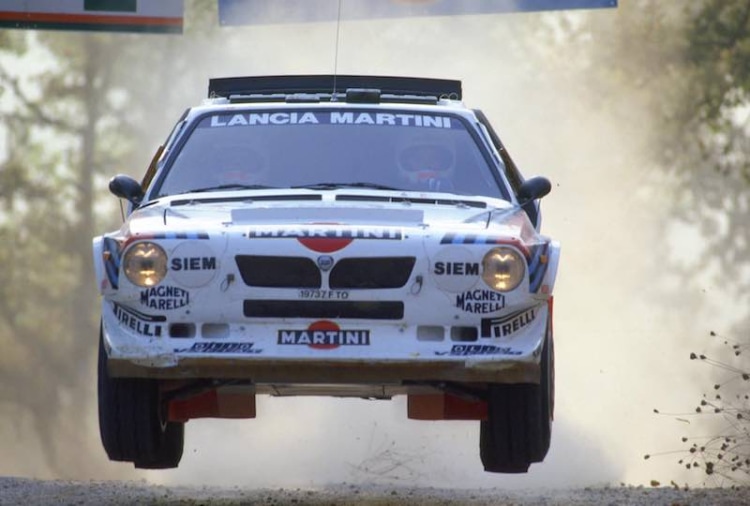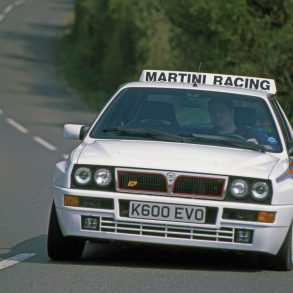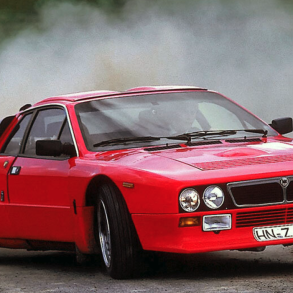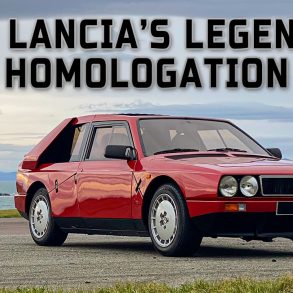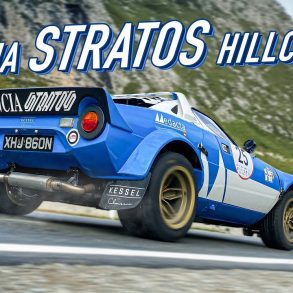Can a hatchback be as good as a supercar? If the hatchback in question is Lancia Delta S4, the answer is most definitely yes. Frankly, the magnificent Delta S4 didn’t have much to do with its humble family-friendly counterpart.
Its rear hatch was actually a clamshell panel concealing a bespoke turbocharged and supercharged engine and you could drive it to the green market provided that you don’t mind getting its suede seats dirty.
But, whereas the street-tamed Lancia Delta S4 Stradale road car was meticulously kept by its owners as if it was a supercar, the rallied up Lancia Delta S4 Corse was there to get dirty.
Lancia Delta S4 at the 1986 Rally New Zealand – Source: KrisMotorsport
More than three decades since its short and tragically cut prime, this rallying supercar still captivates the imagination of enthusiasts worldwide. We’ve decided to dig into its history and see how and why it made such an impact in motorsport.

Background
Lancia got into rallying thanks to Cesare Fiorio who joined Lancia in 1963 and soon formed the HF Squadra Corse out of pure enthusiasm. Whereas Lancia focused to employ its innovations through its elegant and stately cars, Fiorio recognized Lancia’s rallying potential, embarking on a journey that brought Lancia to the very top of rallying.

The first steps towards rallying pantheon came with the Fulvia HF, a cleverly engineered and nimble front-wheel-drive coupé which recorded stellar results with Sandro Munari behind the wheel.
Up to that point, Fulvia’s highlight was its title in the 1972 International Championship for Manufacturers, but that was just the beginning for the leaping red elephant.

Lancia reshaped rallying in 1973 when it introduced the Stratos, the first purpose-built rally car ever created. Thanks to Marcello Gandini’s ingenious design, Ferrari’s 2.4-liter Dino V6, and the legendary Sandro Munari, Lancia Stratos dominated the sport in the following years, but that sadly wasn’t enough for Fiat, Lancia’s parent company since 1969.

Fiat wanted to strengthen its brand recognition by entering top tier rallying, so the Stratos was pushed out in favor of Fiat 131 Abarth. Yet, even without full factory support, the superbly engineered Stratos managed to score more wins in hands of capable and well organized private teams. With that in mind, Lancia wasn’t exactly inactive even during HF Squadra Corse’s dormant period.
After the 131 completed its mission, it was time for Abarth to team up with Lancia on the 037 project for the newly formed and highly experimental FIA Group B rallying. The newly formed regulations effectively replaced Group 4 and Group 5 for the 1982 World Rally Championship season.
The 037 utilized innovative engineering solutions and as such it managed to snatch the World’s Championship for Constructors in 1983. But, regardless of its ingenuity, the 037 couldn’t cope with two more capable adversaries, Peugeot 205 T16 and Audi Quattro.

Sporting four wheel drive as opposed to Lancia’s rear-wheel drive, both the Peugeot and the Audi had an upper hand due to better traction. So despite all technological advancements like supercharging over turbocharging, the 037 was made obsolete.
Development
Lancia noticed the growing threat from Audi in the 1983 season, so Cesare Fiorio and Claudio Lombardi commenced with engineering the replacement during the same year. The team started out with the development of a new car loosely based on one of Lancia’s family cars, the Delta.

The development team started out with just a name because the car was in fact built from the ground up, carrying over just some parts of suspension architecture from the Lancia 037. The project was initially dubbed 038, but in the end, it got the name Delta S4 (supercharged 4-wheel drive).
Just like the Stratos and the 037, the upcoming rally car had a midship mounted engine. The technology was applied from the final evolution of the Lancia 037, but this time Abarth used a 1.8-liter version of Fiat’s block.
For developing the much needed all-wheel drive, Lancia joined hands with Hewland, an innovative UK-based transmission manufacturer with an extensive motorsport background.
The engine was developed before the bodywork and the chassis, so the system was tested by using the 037 as a mule. This chimera was called Mazinger as a nod to a mecha manga and anime series of the same name. It was a 1983 prototype still using rear-wheel drive since notable changes regarding the engine placement prolonged the period needed to develop the gearbox and four-wheel drive.
In late 1983, an Italian company CECOMP S.p.A. completed the first chassis engineered by Abarth, so the development team and the drivers were ready to test it and compare it to the 037. The first car was completed in June 1984 and after extensive testing, it was finally unveiled on December 13, 1984.

The use of different materials in the street-legal homologation special and full-on competition cars also meant that the Lancia Delta S4 was built by two different outlets. The Delta S4 Stradale was handbuilt by Carrozzeria Savio, a relatively unknown coachbuilder from Turin, while the Delta S4 Corse cars were completed by Fiat’s in-house Abarth personnel.
Delta S4 Homologation
The Group B car rulebook stipulated that 200 identical roadgoing variants of the car had to be presented for a competition variant to qualify and the Delta S4 was finally homologated on November 1st 1985.

Now, certain sources claim that the actual number of produced models is closer to 150, while some argue that the numbers were in fact much smaller. That wouldn’t be a surprise considering Lancia’s legendary ruse when homologating the 037 by presenting the same batch of cars on two different lots.
The delays in development meant that the Delta S4 race car was ready to debut at the very end of the group B rally car 1985 season which it did in great style, but more on that later. Now, let’s see what made Lancia Delta S4 so formidable.
Chassis
For the competition cars to maintain light weight, Abarth constructed the frame of the S4 in used lightweight chrome-molybdenum tubular spaceframe with carbon fiber reinforcements.

The tubular frame of the Delta S4 was constructed in a similar manner to the 037, yet with improved rigidity, enabling the car to perform better under demanding conditions of various rallying across the championship.
Body
Even though the car shared its name with the 5-door hatchback, the Delta S4 Stradale retained only the front grille, the windshield glass and rear lights with its pedestrian namesake. The headlights were sourced from the Fiat Ritmo and virtually everything else was unique for this car.

The two-door hatchback-like car featured lightweight epoxy and fiberglass body panels with both the front and the rear being clamshell panels. The S4 Stradale featured the iconic flared fenders which later found their way onto the Delta HF Integrale, whereas the large side scoops covering the whole C pillar fed air to the turbo and supercharger intercoolers mounted horizontally behind the engine bay cover.

The imposing look of the Delta S4 Stradale was upped even more in the competition-ready Corse trim. The front clamshell panel featured a Gurney flap on the hood and a front splitter with aerodynamic winglets moulded into the edges of the front bumper panel. The rear had exposed exhausts, and the roof mounted spoiler featured a prominent aerodynamic wing.

The body of the Corse version was constructed in lighter carbon fiber composite with hollow shell Kevlar doors keeping the weight even more down. Unlike the glass windows of the S4 Stradale, the Lancia Delta S4 Corse had fixed perspex windows.
Engine and Transmission
Carrying over from the 1984 variant of the 037, the Delta S4 had a Fiat Twin Cam 16-valve inline-four engine.
Originally developed by Aurelio Lamperdi, this aluminum alloy engine had been in production since 1966 and over the course of decades, it powered various Fiats, Alfa Romeos, and Lancias. In the case of the Delta S4, it was one of its most extreme iterations as it was thoroughly reworked by Abarth, officially getting the name Abarth 233 ATR 18S.

Unlike the 2.1-liter unit from the 037 EVO, the Delta S4 used the 1.8-liter variant which enabled the car to stay under the 2.5-liter class with a minimum weight of 1,962 lb or 890 kg, essential for rally success. Also, for better weight distribution due to the centrally mounted transfer case, the engine was rotated 180° compared to its position on the Lancia 037.
Just like in the 037 EVO, the engine was twin-charged, meaning it was both turbocharged and supercharged to eliminate issues with turbo lag – a common occurrence in early turbocharged cars. This complicated system was well-engineered and proved to be reliable during pre-production testing and Delta S4’s competing years too.
In the lower RPM range, it was the supercharger boost giving additional power to the engine while the turbo activated to work in unison with the supercharger midway into the RPM range. Finally, when the engine was getting to its redline, the supercharger disengaged letting the turbo provide all the boost.
In the Delta S4 Stradale, this Abarth-modified twin-charged 1.8-liter Twin Cam ran on 7.0:1 compression ratio and pumped out 247 hp at 6,750 rpm and 215 lb?ft of torque at 4,500 RPM, courtesy of a KKK K26 turbo and Abarth R18 Volumex supercharger with two air-to-air intercoolers.

For the Corse variant, the Abarth was able to extract way more power from the setup. Various sources claim that the power during engine testing surpassed the 1000 hp mark, but the rally cars ran around 450 horsepower at 8,000 RPM and 289 lb-ft of torque for the 1985 season.
In 1986, the figures were raised to 480 hp at 8,400 RPM and 362 lb-ft of torque, although the power output was unofficially over 550 horsepower. Moreover, Markku Alen claimed that his Delta S4 had 750 horsepower at the final event of the 1986 season.
The S4 Corse engine ran on 7.1:1 compression, while the KKK K27 Turbo and Volumex R18 supercharger provided a boost of 1.5 bar. Both the competition and the street trim engine had dry-sump lubrication, but only the racing car had a functional roof-mounted scoop for the oil cooler.

This tour de force of an engine was mated to Hewland 5-speed dogleg manual gearbox sending the power to the wheels via innovative three-differential all-wheel drive. In the Corse variant, the central Ferguson viscous coupling allowed front-to-rear power distribution to range from 25:75 to 40:60 to both the front and the rear ZF limited-slip differential.
On the other hand, the Delta S4 Stradale had fixed 30:70 power distribution between the front open and the rear limited-slip ZF differential via central Ferguson viscous coupling.
To give some idea of this mechanical system’s efficiency, the Delta S4 Corse famously ran 0-60 MPH in 2.4 seconds on gravel, nearly identical to the F1 cars of the era.
Suspension and steering
The front suspension of the Delta S4 utilized double unequal wishbones with coil springs, telescopic hydraulic shock absorbers, and anti-roll bars, whereas the rear suspension, comprised double unequal wishbones, with twin telescopic hydraulic shock absorbers, a separate spring and anti-roll bars.

Both the S4 Stradale and the S4 corse had rack and pinion steering with 2.5 turns lock to lock and a ratio of 14.4:1. The street-going homologation car had pneumatic power-assisted steering.
Brakes, Wheels and Tires
For much needed efficient stopping power Abarth fitted the S4 with both front and rear 300mm ventilated disc rotors with Brembo calipers, both two-piston and four-piston calipers in the front and rear two-piston calipers in the back. For the 1986 season, the braking system was improved by installing four-piston calipers on all four wheels.

The Delta S4 was fitted with 16×8-inch front and 16×10-inch forged Speedline alloy wheels wrapped in Pirelli P7 Corsa high-performance rubber.
Interior
Out of all three Lancia’s greatest homologation specials, the Delta S4 had by far the most comfortable, some would even say luxurious interior. The beautifully sculpted and profiled seats, the headliner, and the interior were wrapped in teal Alcantara, complemented by lush carpeting.

Behind the three-spoke Abarth steering wheel wrapped in black Alcantara, there was the instrument cluster unique to the Delta S4. It was dominated by the speedometer etched to 260 km/h and a 9000 RPM tachometer. Sitting in between was the boost gauge, and a set of vertically placed warning lights, followed by horizontally-oriented fuel, water temperature, oil temperature, and oil pressure gauges.

The central console featured a trip computer, a clock, and an ampere meter alongside various buttons and switches. A far cry from the Spartan Stratos and the 037, the Delta S4 Stradale featured electric windows and air conditioning too.
Racing the Lancia Delta S4
1985
The 1985 season was the first for the Delta S4, but was disastrous for the team. While waiting for the arrival of the new rally car, Martini Racing campaigned the 037 EVO with no success.
It all started at the very first event when Lancia’s star driver Henri Toivonen broke three neck vertebrae after a crash in his 037. As a result of this accident, Toivonen was recovering during the remainder of the season, returning to the 037 in Finland, at the ninth event of the season.

At the 1985 Tour de Corse, the fifth event of the season, Italian driver Attilio Bettega fatally crashed when he lost control of his Lancia 037 and hit a tree. On top of an underwhelming performance, such a tragic loss was the greatest hardship Lancia had to handle during the season.
A glimmer of hope for the team came on the final event of the season, at the RAC Rally in Great Britain where the S4 finally had its glorious debut. Fully recovered from the crash, Henri Toivonen and co-driver Juha Piironen ran the S4 to its first victory with Markku Alen and Kivimäki Ilkka trailing behind.
1986
The 1985 group B rallying season ended with a rollercoaster of emotions and the S4’s promising debut gave a spark for 1986. For the upcoming season, Lancia entered three cars piloted by Toivonen, Alen, and Miki Biasion.

The opening round in Monaco saw Toivonen winning the prestigious rally, yet had to retire at the next round in Finland. Still, Martini Racing got a second-place as Alen finished the rally behind Juha Kankkunen’s Peugeot 205 T16.
In the next event in Portugal, all factory teams decided to stop racing after a severe crash in which Joaquim Santos’ Ford RS200 lost grip, crashing into spectators. After this tragic event in which three people lost their lives, the FIA further tightened the grip due to numerous safety concerns regarding both the drivers and the spectators. The Group B cars were too fast for their own good and flocking spectators looking for thrill were constantly putting both themselves and the contenders in danger.
Sadly, after the Safari Rally which the Delta skipped in favor of 037, Tour de Corse saw another tragedy. A year after Bettega lost his life, it was Henri Toivonen with his co driver Sergio Cresto who didn’t survive a fiery crash at one of the remote sections of the rally. After the car went off the road, its fuel tanks ruptured and instantly caught fire, resulting in a gruesome aftermath.
Prior to the accident, Toivonen made comments about how driving the S4 was exhausting in the later stages of the rally since the car was just too fast and too powerful for a rally like the Tour de Corse.
After the Tour de Corse, further development of Group B was halted indefinitely, yet the season continued with three third spots, five second places, and two more wins for the Delta S4, the last of which was the Olympus Rally in the United States.
Parallel to the Martini Racing Lancias, the S4 also wore Esso and Totip liveries while competing in the European and Italian rally championships, driven by Fabrizio Tabaton and Dario Cerrato. Unsurprisingly, the S4 outright won the titles at both championships.
Legacy
Truth be told, the Delta S4 didn’t complete its main goal of beating Audi Quattro and Peugeot T16 and the deaths of Toivonen and Cresto left a huge mark in rallying as one of the sport’s most tragic events. Following the harrowing Tour de Corse crash, the FIA pulled the plug on Group B, replacing it with the toned-down Group A regulations.
Still, the Delta S4 gained iconic status during its short lifetime which grew even bigger in recent decades marked by the growing and romanticized 1980s motorsports nostalgia.

Moreover, the Delta S4 paved the way for Lancia’s most dominating stint in rallying, where the Group A Delta Integrale HF won the World Rally Championship six years in a row from 1987 to 1992, a record still unmatched to this day.
The Lancia Delta S4 is universally remembered as one of the greatest cars ever made, not just in rallying, but in the whole motorsport. Were it not for the 1986 Tour de Corse crash, the S4 would have evolved into the Delta ECV, where it would most probably annihilate the competition.
Even though that didn’t happen and despite the tragic aura surrounding it, the Delta S4 is still a cherished piece of Lancia’s rich and glorious history.


